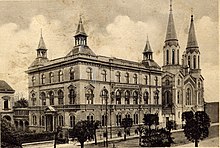Poor School Sisters Notre Dame (Banat)
The poor school sisters Notre Dame are a religious community of the Roman Catholic Church in the western Romanian city of Timișoara ( German Timişoara ).
history
Through the mediation of Bishop Alexander Csajághy of the Diocese of Szeged-Csanád , six sisters of the Munich Order of the Poor School Sisters of Our Lady, founded in 1833, came to what was then Timişoara, who from then on called themselves the "Poor School Sisters Notre Dame".
The subsequent bishop Alexander Bonnaz founded a spacious building complex in the Josefstadt district between 1880 and 1889 , consisting of the motherhouse of the Institute of Poor School Sisters, the Notre-Dame monastery church and several school buildings. The Notre-Dame Klosterschule consisted of a kindergarten, a primary school, a girls' high school, an advanced training school, a teacher training institution and a training school for the teacher training institution. In addition to this, the sisters looked after an orphanage. The order set up a boarding school for some foreign students. Over the years, the order not only opened new monastery schools in Timisoara, but also branches with monastery schools in many Banat villages. In addition to the six original sisters from Bavaria, the order recruited many local school sisters.
In the school year 1880/81 a total of 3982 pupils were taught by 189 school sisters in the twelve schools of the order, in 1881 the educational institution in Timisoara alone had 280 pupils, and 34 applicants for the order were preparing for their educational careers. The monastery school in the Timisoara district of Josefstadt was soon one of the most modern schools in Hungary and was considered exemplary in Europe. In addition to Catholic girls, classes were also open to students of other denominations. After the turn of the century in 1900, many new monastery schools were founded, and the Timisoara school was also expanded.
Between 1925 and 1944 there was a close cooperation between the teacher training institute and the seminary at the Banatia in Timișoara. The German “ethnic group in Romania” was recognized as a legal entity under public law in 1940 and was granted school autonomy by law. It took over all German-speaking schools with the exception of the monastery schools, which continued to exist as religious schools.
At the outbreak of the Second World War , the teaching institutions of the Josefstadt monastery counted 716 female students. The girls' lyceum counted 311 students, mostly of Roman Catholic faith, but with different mother tongues:
- 97 Hungarian
- 87 Romanian
- 86 German
- 4 Bulgarian
- 7 Slovak
- 10 Serbian
- 9 Jewish
- 1 Italian
In 1948 the schools were nationalized by the Romanian communist government and the religious order was dissolved. The approximately 400 sisters were no longer allowed to teach and were released on August 15, 1949 after the monasteries closed. Many of the sisters had to undergo interrogation and torture by the secret police and even suffered years of imprisonment. They found it difficult to find shelter and a livelihood.
After the Romanian Revolution in 1989 , the Order's leadership in Rome attempted to revitalize the monastic community. 72 scattered sisters were brought together and new houses were bought for them, as the expropriated earlier buildings were not restored. The monastery church was renovated; services are held there today in several languages such as Romanian, Bulgarian and German. Classes are limited to religious instruction in several communities.
The order soon received newcomers. In 2002/03 the first Catholic kindergarten in Timișoara was built by the poor school sisters with donations from Germany and the organization Renovabis and opened in October 2003. The kindergarten is attended by around 85 children from Catholic and Orthodox backgrounds. The focus of the kindergarten is on religious upbringing and education, with an introduction to the festivals of the church year.
Trivia
The statue of Mary , which stood in the courtyard of the Notre Dame monastery before the Second World War, was restored by Hans Parison and is now in the courtyard of the rectory of Periam ( German Perjamosch ).
literature
- Franziska Graf: Ninety years of the Notre Dame monastery school of the poor school sisters of Our Lady in the Banat (1858 - 1948) . Bavarian State Association of the LM of the Banat Swabians, Munich 2009, ISBN 3-922979-62-9 .
Individual evidence
- ↑ a b c Hans Gehl : Dictionary of Danube Swabian Life Forms, Institute for Danube Swabian History and Regional Studies - Series of publications, Volume 4 of Donauschwäbische Fachwortschätze, Volume 14 of series of publications by the Institute for Danube Swabian History and Regional Studies . Franz Steiner Verlag, 2005, ISBN 3-515-08671-4 , pp. 97 .
- ↑ a b banaterra ( Memento from May 19, 2012 in the Internet Archive ), BANATerra: Timisoara - the capital of the Banat , section school system
- ^ Federal Ministry for Education in Vienna: 200 Years of Austrian Education Administration 1760-1960, Festschrift . 1960, p. 22 ( online [PDF; 1000 kB ] cited in Lavinia Emeline Gabor: Doctoral thesis using media in German lessons in Romania, taking German bilingualism residues into account , Timișoara, 2007).
- ↑ School Sisters in Romania ( Memento from September 10, 2012 in the Internet Archive ) schulschwestern.de
- ↑ hog-perjamosch.de , hometown community Pejamosch: Obituaries Hans Parison. February 2010




